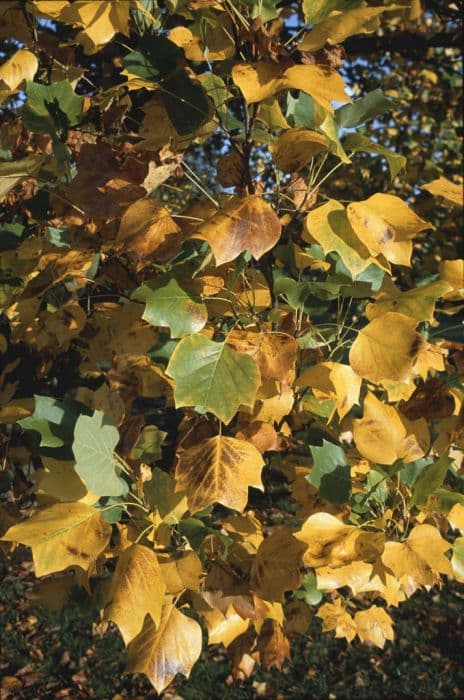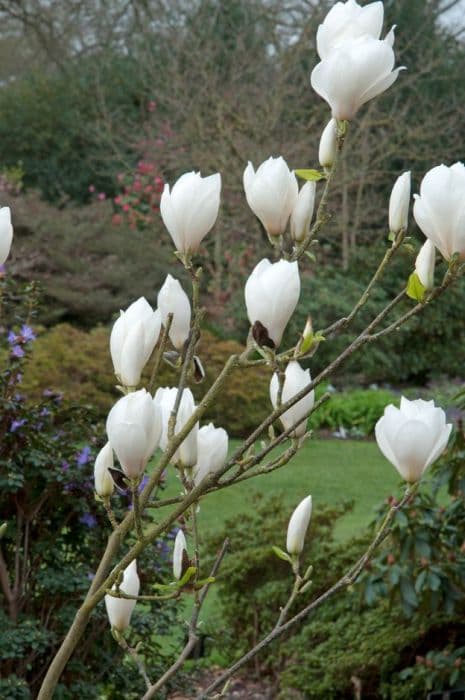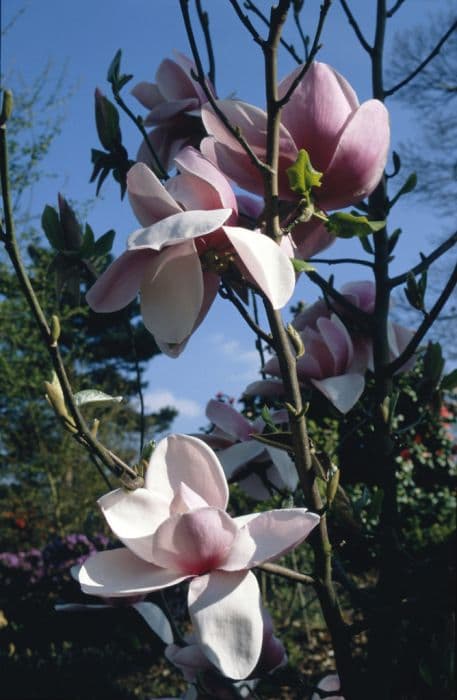Star Magnolia Magnolia stellata 'Scented Silver'

ABOUT
The Magnolia stellata 'Scented Silver', commonly known as Star Magnolia, is a striking ornamental plant that is often admired for its beautiful floral display. This variety is particularly noted for its fragrant flowers that are colored a silvery-white, giving it its descriptive moniker. The flowers are numerous and large, with a profusion of narrow petals that burst forth in a star-like formation, hence the name 'Star Magnolia'. These starry blossoms radiate an alluring aroma that can enchant the senses and enrich any garden atmosphere. This plant's foliage is equally attractive, with leaves that emerge a fresh green color and provide a lush backdrop for the spectacular spring blooms. As the seasons change, the leaves might showcase a palette of color transformation that adds to the visual interest of this plant. The branches spread gracefully, forming an attractive silhouette even when the plant is not in flower. The bark is smooth, providing a subtle textural contrast to the softness of the leaves and the delicate nature of the blooms. Overall, the Star Magnolia 'Scented Silver' is a beloved choice for gardeners looking to add a touch of elegance and sensory pleasure to their landscape.
About this plant
 Names
NamesFamily
Magnoliaceae
Synonyms
Star Magnolia, Silver Star Magnolia
Common names
Magnolia stellata 'Scented Silver'.
 Toxicity
ToxicityTo humans
Star Magnolia is generally considered non-toxic to humans. However, as with many plants, individual sensitivities can vary, and any plant material can cause a reaction in certain sensitive individuals. Symptoms of a potential allergic reaction might include skin irritation, and if ingested, mild gastrointestinal upset could occur. It is always wise to discourage children from eating any non-food plant material due to the potential for allergic reactions or digestive discomfort.
To pets
Star Magnolia is not known to be toxic to pets such as dogs and cats. It does not appear on toxic plant lists provided by major animal poison control resources. However, the consumption of any plant material may cause mild stomach upset in pets if they are not used to it. Signs of gastrointestinal discomfort might include vomiting or diarrhea. If a pet consumes a large amount of any non-food plant, including Star Magnolia, it is advisable to monitor them for any adverse reactions and consult a veterinarian if any worrying symptoms occur.
 Characteristics
CharacteristicsLife cycle
Perennials
Foliage type
Deciduous
Color of leaves
Green
Flower color
White
Height
3-4 feet (0.9-1.2 meters)
Spread
4-6 feet (1.2-1.8 meters)
Plant type
Shrub
Hardiness zones
4-8
Native area
Japan
Benefits
 General Benefits
General Benefits- Ornamental Value: The Magnolia stellata or Star Magnolia is highly valued for its aesthetic appeal due to its showy, fragrant flowers that bloom early in the spring.
- Landscape Variety: It provides variety to landscapes, offering a different flower form and texture compared to many other flowering trees and shrubs.
- Compact Size: Being a relatively small tree or large shrub, the Star Magnolia is suitable for small gardens and spaces.
- Seasonal Interest: Its early spring blooms provide a welcome change in the landscape, signaling the end of winter.
- Wildlife Support: The flowers attract pollinators such as bees, which are essential for the health of an ecosystem.
- Durability: It is relatively cold-hardy, making it a suitable choice for gardens in cooler climates.
- Low Maintenance: Once established, the Star Magnolia requires minimal maintenance compared to many ornamental plants.
- Color Contrast: Its silvery-white flowers can serve as a striking contrast against the dark greens or browns commonly found in the landscape.
- Year-Round Interest: After flowering, it provides structure and greenery throughout the growing season and interesting branch patterns in the winter.
 Medical Properties
Medical PropertiesThis plant is not used for medical purposes.
 Air-purifying Qualities
Air-purifying QualitiesThis plant is not specifically known for air purifying qualities.
 Other Uses
Other Uses- Photography Attraction: Due to its stunning blooms, the Magnolia stellata is a popular choice for photographers looking for natural subjects or needing a beautiful backdrop for springtime photo shoots.
- Study Specimens for Botany: Its unique floral morphology offers a learning opportunity for botany students studying flower structure and pollination mechanisms.
- Educational Gardens: The Magnolia stellata can be grown in educational gardens to demonstrate plant growth, seasonal changes, and ornamental horticulture practices.
- Craft Materials: The woody branches and distinctive seed pods can be used in floral arrangements, wreaths, and other decorative crafts.
- Theme Gardens: This plant is ideal for inclusion in star-themed gardens due to its star-shaped flowers, offering a thematic landscape design element.
- Literary Inspiration: The plant can serve as a muse for writers and poets, with its striking appearance in literature as a symbol of purity and dignity.
- Feng Shui Element: In the practice of Feng Shui, the plant can be used to attract positive energy, due to its lush blossoms and graceful form.
- Culinary Presentations: Although not edible, the petals can be used for plating decoration in high-end culinary presentations before they are removed for consumption.
- Bee Education: The Magnolia stellata is an early bloomer, providing an educational opportunity for teaching about the importance of bees and other pollinators in the ecosystem.
- Seasonal Celebrations: The tree can be incorporated into seasonal festivities, such as a symbol of renewal during spring events and ceremonies.
Interesting Facts
 Feng Shui
Feng ShuiThe Star Magnolia is not used in Feng Shui practice.
 Zodiac Sign Compitability
Zodiac Sign CompitabilityThe Star Magnolia is not used in astrology practice.
 Plant Symbolism
Plant Symbolism- Perseverance and Endurance: The Magnolia stellata, commonly known as the Star Magnolia, often endures cold climates and blooms early, sometimes even when there's still frost. Its ability to withstand tough conditions symbolizes resilience.
- Purity and Nobility: The Star Magnolia blooms with white flowers, a color often associated with purity. Additionally, magnolias are considered ancient and majestic, thus symbolizing nobility.
- Femininity and Dignity: With its delicate, star-shaped blossoms, the Star Magnolia is frequently associated with feminine beauty and dignity.
- Inner Strength: The sturdy trunk and branches of the Star Magnolia represent inner strength and stability.
- Love of Nature: With its lush greenery and fragrant flowers, the Star Magnolia can symbolize an individual's love for the natural environment.
 Water
WaterStar Magnolia requires even moisture and should be watered deeply once a week, providing about 1.5 to 2.5 gallons of water per session. During hot or dry spells, increase watering frequency to twice a week. Ensure that the soil is well-draining to avoid waterlogging, which can lead to root rot. During winter, when the plant is dormant, reduce watering but do not let the soil completely dry out. Adjust watering based on rainfall and check the topsoil moisture regularly to gauge the need for additional water.
 Light
LightStar Magnolia thrives in full sun to part shade. The ideal location is a spot that receives direct sunlight for at least 4 to 6 hours a day, with some dappled shade during the hottest part of the afternoon. Avoid deep shade, as it can result in sparse flowering. Morning sunlight with afternoon shade can also be beneficial in preventing heat stress during summer months.
 Temperature
TemperatureStar Magnolia prefers temperate climates with a temperature range between 20°F and 80°F. It can withstand short periods of temperatures down to 0°F but sustained freezes may damage the plant. The ideal growing temperature for these plants is between 60°F and 70°F, which encourages healthy growth and flowering.
 Pruning
PruningPruning Star Magnolia is beneficial for maintaining its shape and encouraging healthy growth. The best time to prune is soon after it finishes blooming in spring to avoid cutting off next year's buds. Prune to remove any dead or damaged wood, and to shape the plant. Thinning out congested branches can also improve air circulation, which helps prevent disease.
 Cleaning
CleaningAs needed
 Soil
SoilStar Magnolia thrives best in well-drained, slightly acidic to neutral soil with a pH of 5.5 to 7.0. A good soil mix for this plant would be a combination of loamy soil, peat moss, and compost to provide ample drainage and rich nutrients.
 Repotting
RepottingStar Magnolia typically does not require frequent repotting and should be repotted only when it has outgrown its current container, which may be every 3 to 5 years.
 Humidity & Misting
Humidity & MistingStar Magnolia prefers moderate humidity levels but is tolerant of the varying humidity typical of outdoor conditions.
 Suitable locations
Suitable locationsIndoor
Provide bright light, ensure moderate humidity, and water thoroughly.
Outdoor
Plant in sun to part shade, shelter from strong winds, mulch roots.
Hardiness zone
4-8 USDA
 Life cycle
Life cycleStar Magnolia 'Scented Silver' begins its life as a seed, which, when conditions are favorable, germinates and develops into a seedling. The seedling grows into a juvenile plant, producing its first leaves and establishing a root system. As it matures, it enters the vegetative stage wherein it develops a woody stem and branches, with foliage that expands each growing season. Once mature enough, it enters the reproductive phase, typically in early spring, producing fragrant, star-shaped white flowers before leafing out. After pollination, often by insects attracted to its scent and color, the flowers develop into follicle-type fruits that release seeds, completing the life cycle. The plant may then enter a period of dormancy during the colder months before resuming growth in the next season.
 Propogation
PropogationPropogation time
Spring
Magnolia stellata, commonly known as Star Magnolia, is often propagated by softwood cuttings, a method popular for its relative simplicity and effectiveness. The best time for taking softwood cuttings is in late spring to early summer when the plant's new growth is just beginning to harden but is still flexible. Cuttings should be about 3 to 6 inches long, with a cut made just below a set of leaves, and the lower leaves removed. The cut end is then treated with rooting hormone and placed into a well-draining rooting medium such as a mix of peat and perlite. To maintain a high humidity level around the cuttings, you can cover them with a plastic bag or place them in a greenhouse environment. Lastly, keeping the medium consistently moist but not waterlogged is crucial for the successful rooting of these cuttings, which can take several weeks to months.









